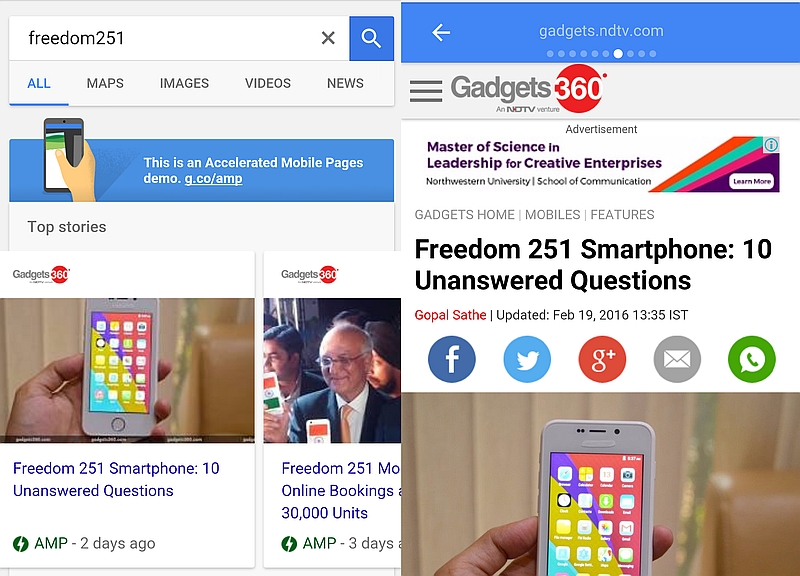- Home
- Internet
- Internet Features
- Google's Accelerated Mobile Pages are Coming: Here's What You Need to Know
Google's Accelerated Mobile Pages are Coming: Here's What You Need to Know

Google has been talking about accelerated mobile pages (AMPs) for a while and with most of the ground work now in place, the Mountain View giant is ready to flip the switch on a project that could have a far-reaching impact on how you and I use the mobile Web.
What are AMPs?Accelerated mobile pages are special versions of existing Web pages that are served to users at a much faster speed than regular pages. The improvements in speed are achieved by a combination of three factors: the content producers host a slightly modified version of their page, minus some of the javascript that can slow the page down, replacing it with Google-recommended code. It's important to note that the page looks and feels identical to the original page - complete with the layout of the publisher's existing website - so most users are unlikely to note any difference when viewing AMPs.
These AMPs are served via Google's CDN (Content Delivery Network), which means users are connecting to a server that is close to their geographical location, further eliminating the possibility of network delays. Finally, when you are at the search results page, the accelerated mobile pages are pre-fetched, which means when you do tap on them, the pages load faster than other links.
What do AMPs mean for you as a user?
You will see accelerated mobile pages in a special carousel that appears on Google search results page. This carousel will appear right at the top of the search results, which shows the importance Google is putting on the AMP project. Given its priority placement and fast loading times, it's extremely likely that the AMP carousel will cannibalise tap-through rates. Google says the order of the pages inside the AMP carousel is decided using the same combination of factors that determine order of traditional search results.
Once you tap on an AMP inside the carousel, the page should load faster than you are used to, and like we mentioned earlier, it should look just like the 'regular' mobile page of that publisher. Interestingly, swiping left or right once the AMP has finished loading lets you quickly switch to a page of another publisher, in the same order that the pages appeared inside the carousel.
What do AMPs mean for publishers?
Google has made it relatively simple for publishers to join the AMP program. There are guidelines anyone can follow to create an AMP equivalent of their mobile Web page. A <link rel="amphtml"> tag is used to link a Web page with its AMP counterpart.
Modern Web pages are slowed down by host of third-party JavaScript code, and Google recommends replacing it with code that uses its libraries, which means there are fewer servers to connect to when serving the page, and code that's better optimised, resulting in better overall performance. When using AMP, publishers are restricted to a subset of HTML and CSS as well to further improve performance.
Google said Wordpress is working on adding AMP support on its platform, which means millions of Wordpress-powered sites will be automatically WMP-enabled when the work is completed. Anyone can make AMP equivalents of their current Web pages by following Google's guidelines. You can implement Google AMP - complete with using Google's CDN for free - even if you don't use Google's ad code on your page.
Google AMP vs. Facebook Instant
Google says publishers will be able to retain most elements of their pages, including existing ad networks and third-party integrations like Taboola. However, support is limited to the bigger networks - though Google says it is exploding this list - and not all ad formats are supported at this point, though that may change in the future. This is in contrast to Facebook's Instant Articles, which at this point do not support integrations like Taboola.
From a user's perspective, Facebook Instant articles are available only via the Facebook app as they are designed to keep you within the Facebook ecosystem. AMPs, on the other hand, should work on any modern mobile Web browser, though you obviously need to get to the page via Google search.
When does AMP rollout?
Major publishers across the world and in India - including NDTV - are already on board AMP. Google has been silent on the exact date of the rollout, though rumours suggest it is likely to happen within this month. If you can't wait to try out AMP, simply point your mobile browser to http://g.co/ampdemo right now to give them a spin.
Catch the latest from the Consumer Electronics Show on Gadgets 360, at our CES 2026 hub.
Related Stories
- Samsung Galaxy Unpacked 2025
- ChatGPT
- Redmi Note 14 Pro+
- iPhone 16
- Apple Vision Pro
- Oneplus 12
- OnePlus Nord CE 3 Lite 5G
- iPhone 13
- Xiaomi 14 Pro
- Oppo Find N3
- Tecno Spark Go (2023)
- Realme V30
- Best Phones Under 25000
- Samsung Galaxy S24 Series
- Cryptocurrency
- iQoo 12
- Samsung Galaxy S24 Ultra
- Giottus
- Samsung Galaxy Z Flip 5
- Apple 'Scary Fast'
- Housefull 5
- GoPro Hero 12 Black Review
- Invincible Season 2
- JioGlass
- HD Ready TV
- Laptop Under 50000
- Smartwatch Under 10000
- Latest Mobile Phones
- Compare Phones
- OPPO A6 Pro 5G
- OPPO A6s
- OPPO Reno 15 Pro Max
- Honor Win RT
- Honor Win
- Xiaomi 17 Ultra Leica Edition
- Xiaomi 17 Ultra
- Huawei Nova 15
- Asus ProArt P16
- MacBook Pro 14-inch (M5, 2025)
- OPPO Pad Air 5
- Huawei MatePad 11.5 (2026)
- Xiaomi Watch 5
- Huawei Watch 10th Anniversary Edition
- Acerpure Nitro Z Series 100-inch QLED TV
- Samsung 43 Inch LED Ultra HD (4K) Smart TV (UA43UE81AFULXL)
- Asus ROG Ally
- Nintendo Switch Lite
- Haier 1.6 Ton 5 Star Inverter Split AC (HSU19G-MZAID5BN-INV)
- Haier 1.6 Ton 5 Star Inverter Split AC (HSU19G-MZAIM5BN-INV)

















